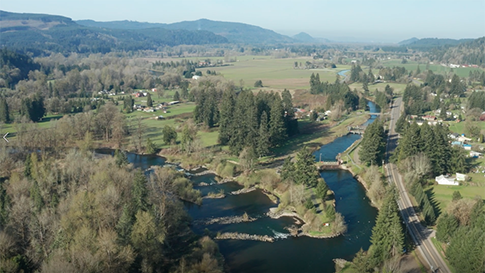Related News
Related News
-
Sustainability Snapshot - Celebrating Energy Efficiency Projects in the Community
Sustainability Snapshops highlight impactful projects completed by EWEB's Customer Solutions department, as a way to celebrate the meaningful work happening behind the scenes.
Find Out More -
McKenzie Valley electric service territory realignment study reaches key milestone
EWEB Commissioners approved a resolution authorizing the General Manager to negotiate and execute agreements with Lane Electric Cooperative regarding a potential realignment of electric service territory in the McKenzie Valley at the Board’s December meeting.
Find Out More -
EWEB secures $2.5 billion of reliable, affordable, carbon-free energy for customers
The new contract with EWEB’s largest energy supplier, the Bonneville Power Administration, forms the foundation of a diverse energy portfolio.
Find Out More -
Women in STEM: Meet the Hydro Project Engineer Building Habitat for Salmon
EWEB Engineer Associate Val Chang found her way to the McKenzie River from Los Angeles, inspired by heritage trips to the waters of Taiwan and key mentors along the way.
Find Out More -
Public Power Week Poster Contest Winners 2025
The results are in! View the winning posters from EWEB's 2025 Public Power Week Poster Contest.
Find Out More -
EWEB Hometown Heroes compete internationally
Out of 290 teams from 14 different countries, EWEB's Lineman Rodeo team places in the top third of competitors.
Find Out More -
EWEB's Halloween Truck-or-Treat is a huge success
Community members are accustomed to spotting EWEB trucks around Eugene streets and neighborhoods. But last week, those familiar vehicles looked a little different. At EWEB's second annual Truck-or-Treat Customer and Crew Appreciation Event, our fleet transformed into a festive Halloween spectacle.
Find Out More -
Let's Talk Turkey. Is your family ready for winter?
We're heading into the holidays, but that also means snow, ice, and not-so-nice weather might be in the forecast. Here are some tips to prepare in advance.
Find Out More -
Vote for your favorite Public Power Week Posters
The top five submittals will receive awards. Help us pick the winners.
Find Out More -
EWEB Hosts Annual Spill Drill to Protect McKenzie River
EWEB led emergency responders in its annual “spill drill” on the McKenzie River on Wednesday, Oct. 15, at the Trail Bridge Campground.
Find Out More -
Electric Projects underway in North & South Eugene
Underground lines and disaster-resilient power poles are part of EWEB’s infrastructure upgrade near Eugene’s largest natural resource area.
Find Out More -
EWEB general manager to retire in 2026
EWEB launches nationwide search for next leader to continue the progress of the last decade and ensure a smooth transition.
Find Out More -
Quartz Creek: Setting the Stage for Floodplain Restoration
The project resets the floodplain along 1.8 miles of a formerly channelized creek to improve water quality, fish habitat and natural disaster resiliency.
Find Out More -
You can’t predict the next disaster, but you can prepare
The earthquake lasted less than a minute. But now the power’s out. The tap runs dry. Cell service is spotty. Would you be ready?
Find Out More -
EWEB completes helicopter installation of salmon habitat features
EWEB adds downed trees and 2,000 tons of gravel to the Uupper McKenzie River below Tamolitch Falls to improve spawning habitat.
Find Out More - Show More
EWEB Puts More Water Into River to Help Fish
May 14, 2021

EWEB Generation staff on May 13 started diverting less water into the Walterville Power Canal to increase McKenzie River flows in the bypassed reach of the river to improve fish migration and water quality.
Under our federal operating license, the Walterville hydroelectric project is allowed to divert up to 2,577 cubic feet per second (cfs) into the canal during normal operations. The license requires us to maintain minimum instream flows of 1,000 cfs in the bypassed reach of the McKenzie at all times. We typically try to keep instream flows at around 1,200 cfs.
However, in 2018 we made an operational decision to voluntarily adjust the flow going into the Walterville Canal during low flow years in order to maintain 10% more flow in the river than the canal from June through October. Maintaining more flow in the river than in the canal improves fish migration and enhances water quality and recreational use during the summer months.
With the unseasonably warm and dry conditions this spring, and with adult salmon already present in the McKenzie River, staff made the decision to keep more water in the river immediately. We originally planned to begin diverting less water to the canal on May 20 due to the low flows.
"We decided to put more water in the bypassed reach of the McKenzie River at this time because we are hearing anecdotally that adult Spring Chinook are showing up a bit earlier than usual," said EWEB Generation Manager Lisa Krentz. "This will have a minor financial impact, but with the low river conditions we're experiencing, we felt it was the right decision."
On the morning of May 13, the power canal was running at about 1,700 cfs, and the bypassed reach of the McKenzie was flowing at about 1,200 cfs. By the morning of May 14, the bypass reach was running at approximately 1,700 cfs and the canal at 1,200 cfs.
This is the third year EWEB has voluntarily decreased diversion into the canal to maintain an additional 10% more flow in the river. This "low-flow" operation will continue through October.
The Walterville powerhouse, located off Camp Creek Road northeast of Springfield, can generate about 8 megawatts of electricity, enough to power approximately 4,000 homes or roughly equal to about 3% of Eugene's average daily consumption of electricity.

